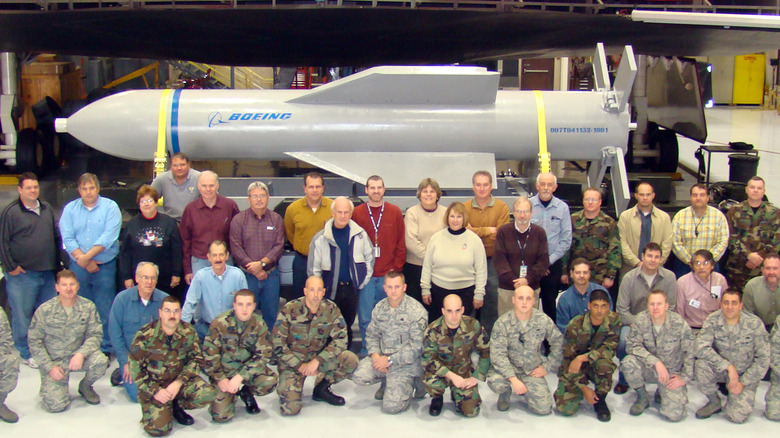What Makes The 30,000-Pound Bunker Buster Bomb So Devastating
In the wake of conflict between Israel and Iran, the topic of so-called "bunker-buster" munitions has come up. Reportedly, vital parts of Iran's nuclear development activity take place in mountainous regions underground. If Israel needed to inflict any meaningful damage, it would need bunker busters. The biggest of which is the GBU-57 Massive Ordnance Penetrator. NPR notes that a lot about the specific bomb is classified, and it, supposedly, never been used in combat.
From what the United States Air Force is willing to divulge, the GPS-guided bomb is 20.5 feet long and "designed to penetrate up to 200 feet underground before exploding." The entire bomb weighs 30,000 pounds with the bulk of the weight being taken up by a hardened penetrator designed to punch through concrete, rock, or otherwise hardened targets. The actual explosive charge is 5,300 pounds. The specific composition of the penetrator is not information that is available to the public. However, the Defense Threat Reduction Agency noted in a report from 2008 that it was developed to be "ten times more powerful than the U.S. Air Force's current weapon, the BLU-109." The BLU-109, another bunker buster uses a steel penetrator built into the case of the bomb.
A stealthy delivery for a big bomb
The weapon was first conceived of all the way back in 2004, around the time the United States was getting involved in conflicts in Iraq and the greater Middle East. Mockups were made and fitted to B-2 bombers as part of a test with Boeing in 2007. It wasn't tested until 2012, where it was dropped on mocked-up targets in New Mexico, according to the United States Air Force. As of now, there is only one aircraft capable of actually carrying the GBU-57 if it were to be used in combat, that's the B-2 Spirit "Stealth Bomber."
As recently as 2015, 20 GBU-57s were contracted to be used with the B-2, although it is not known how many bombs are in the current stockpile. The United States is the only country that uses the B-2, meaning that if Israel needed to use the GBU-57 to complete its goals, the U.S. Air Force would have to step in to assist, further complicating the GBU-57's deployment and the conflict at large.

